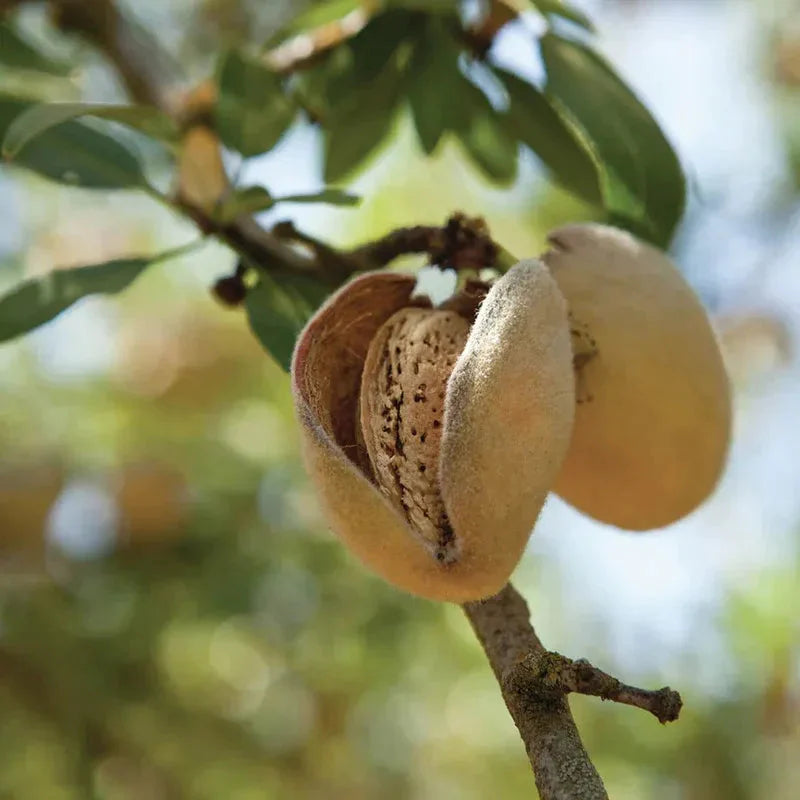Ever wonder about how almond trees are grown? It's really not that different from cultivating most trees. Here are the basic phases:
- Planting: Almond trees can be grown from either seeds (almond pits) or nursery-bought trees. However, planting from seeds may result in variability in tree characteristics. It's more common to plant grafted or budded trees from a nursery to ensure consistent quality and characteristics.
- Soil and Location: Almond trees thrive in well-drained soils with a pH of around 6-7. They prefer full sunlight and a warm climate, making them well-suited for Mediterranean-type climates.
- Growth Stages:
- Seedling Stage: After planting, almond trees begin as seedlings with a single main stem (trunk). During this stage, they focus on establishing their root system and developing a strong stem.
- Young Tree Stage: As the tree grows, it develops branches and leaves. Regular pruning may be required to shape the tree and encourage a strong framework of branches. Proper pruning helps create an open canopy that allows sunlight and air to reach all parts of the tree.
- Flowering and Pollination: Almond trees typically begin to flower in late winter or early spring, before the leaves emerge. The flowers are usually pink or white, and they require cross-pollination for successful fruit set. Honeybees are commonly used to pollinate almond orchards.
- Fruit Development: After successful pollination, the flowers develop into fruits, which are drupes with a hard outer shell that contains the edible almond seed. The fruit matures and dries on the tree.
- Harvesting: Almonds are harvested once the outer fruit hull splits open. This usually occurs in late summer or early fall, depending on the variety and growing conditions. Mechanical shakers are often used to gently shake the almonds from the tree branches. After harvesting, the nuts are dried to reduce moisture content.
- Mature Tree Stage: Almond trees can live for several decades, producing a consistent crop of nuts each year under proper care. Mature almond trees can reach heights of around 15-30 feet, with a spread of 10-20 feet.
Almond tree care can make all the difference between solid tree growth and a bountiful harvest. Irrigation is very important. Almond trees need regular and deep watering, especially during the growing season and when the nuts are developing. Proper irrigation helps prevent stress and ensures healthy fruit development. Fertilization is also essential for almond tree growth and nut production. It's important to test the soil and ensure that the trees are getting the nutrients they need.
Disease and pest management is another big factor. This is especially challenging for organic almond tree growers. Almond trees are susceptible to various pests and diseases, including aphids, mites, scale insects, and fungal infections. Growers regularly monitor and apply organic certified pest management strategies that prioritize the environment's health.
A lot of tender loving care goes into growing almond trees. Sometimes Mother Nature provides a huge help and other times a cold winter can bring frost damage and ruin entire harvests. A successful almond tree growth and harvest requires attention to proper planting, irrigation, pollination, pest control, and care throughout the tree's lifecycle.
Here are more articles to read if you're interested:
- https://gardenerspath.com/plants/nut-trees/growing-almonds/
- https://www.thespruce.com/how-to-grow-almond-trees-4779869
- https://www.gardenersworld.com/how-to/grow-plants/how-to-grow-an-almond-tree/
- https://homeorchard.ucanr.edu/Fruits_&_Nuts/Almond/
- https://wikifarmer.com/almond-tree-soil-requirements-and-preparation/
- https://www.almonds.com/why-almonds/almond-lifecycle

